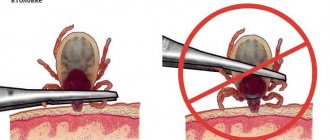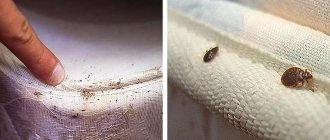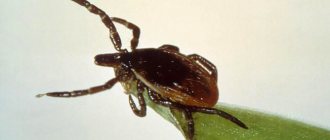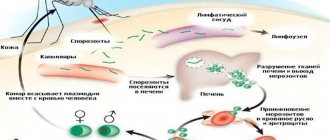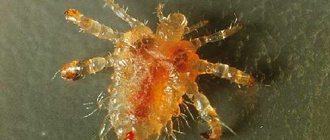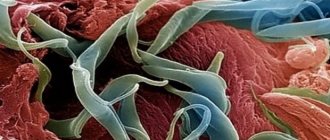Author:
Savina Elizaveta Sergeevna
therapist, surgeon, dermatologist, work with small rodents and rabbits
Ear mites (Otodectosis) are a problem not only for homeless and street animals, but also for completely healthy pets. Most cat owners experience this disease, but this disease is by no means uncommon in dogs. The consequence of this pathology is otitis media in animals.
Few people know how to treat it, much less how to detect it. Often, owners think that the animal has simply dirty its ears, since, apart from constant itching, this disease has no more characteristic and noticeable symptoms, and increased secretion of wax is mistaken for ordinary dirt.
The causative agent of the disease
The causative agent is O. cynotis - a scabies mite-carpet beetle of oval, tortoise-shaped shape, off-white color, with a brown tint in places with stronger chitinization. The head, chest and abdomen are fused into one whole. The proboscis is located on the front of the body. Females are much larger than males. The size of females is 0.32-0.75 mm, males 0.2-0.6 mm. In females, the posterior end is rounded, and in males it is equipped with two abdominal processes with a tuft of setae on each. There are four pairs of legs on the ventral side of the tick. Each leg consists of five segments (coxa, trochanter, femur, tibia, tarsus). At the tops of the tarsi there is a soft membranous pretarsus (sucker or ambulacra). The first three pairs of limbs are well developed, the fourth pair is rudimentary in females. The suckers in females are tulip-shaped, located on short non-segmented rods on the first and second pairs of limbs, in males - on all four. The proboscis is gnawing, horseshoe-shaped. Mites live on the surface of the skin and feed on exfoliated epidermal cells, scales and dry crusts of the skin.
The anal and copulative openings are located at the posterior end of the body. The female lays from several dozen to hundreds of eggs during her life. The eggs are oval in shape, covered with a thin shell, 0.18-0.2 mm long and a maximum width of 0.08-0.09 mm.
Arthropod parasites settle in the hearing organs of a pet, injure delicate skin, and their saliva and feces activate irritation and itching. Insects live only on animals, so people do not become infected.
They prefer to feed on lymph, blood and skin particles.
Main symptoms of ear mites
Signs of otodectosis damage appear immediately:
- the pet becomes restless. Constantly shakes his head, scratches his ears with his paws, trying to get rid of the unpleasant itch from tick bites;
- ears are hot to the touch and swollen;
- when examining the inner surface of the ear, dirty accumulations of tick excrement mixed with blood from scratching and bites;
- an unpleasant odor emanates from the ears due to suppuration of the wounds, as bacterial microflora attaches;
- the pet loses activity and its body temperature may rise.
The initial stage of the disease occurs in a latent form and is not always detectable.
It is much easier to diagnose the disease in a clinic than at home. The specialist carefully examines the pet, identifies primary signs of otodectosis and conducts microscopy. If the animal’s condition allows it, then it undergoes an otoscopy - an instrumental examination of the surface of the auricle and membrane. A positive result and the overall clinical picture influence the choice of therapy.
Diagnostics
Ear mites in humans, whose treatment is carried out comprehensively, are very difficult to determine at any stage of ear damage, so they are diagnosed using different methods:
Inspection and collection of information
When examined by an otolaryngologist, the doctor may note the presence of symptoms of ear mites: swelling and redness inside the ear. Examination of the auricle is considered the most effective way to identify ixodid and arags ticks, which a doctor can see with the naked eye. Based on the degree of damage to the ear, the doctor can determine the approximate time of infection and the degree of damage to the body.
If a person is infected with a Demodex mite, an external examination of the auricle, even with a magnifying glass, will not give any results. In this case, additional examination is required, which includes:
Direct microscopy method
This method effectively and painlessly allows you to determine the presence of any parasite in the ear. A swab is taken from the patient's ear for examination under a microscope. In the presence of demidex mites, large individuals are easily distinguishable on the glass surface when examined under a microscope.
For analysis, a skin scraping is taken from the patient's ear using a special device, which is transferred to glass for further study. Scraping of biomaterial allows you to determine the presence of parasites and the remains of their vital activity during the day. The smear is done at a medical center and its cost is about 1000 rubles.
Analysis of sebaceous gland secretions
The sebaceous glands in humans, in small quantities, squeeze out small parasites along with sweat. The study makes it possible to establish the presence of demodicosis in a separate area of the body, but does not give an idea of the extent of the damage.
The study is carried out by taking a sample from the sebaceous gland, in which the parasite may presumably be located, and is painful. The analysis is carried out only in specialized medical laboratories, its cost ranges from 1,500 to 3,000 rubles.
Surface biopsy method
The superficial biopsy method is rarely used to identify ear mites due to the painful procedure, but in some cases it can easily identify the parasite. For examination, using an adhesive substance and a special scalpel, a separate area of the affected surface of the skin from the patient’s ear is taken for study.
The material is placed on glass and examined under a microscope for the presence of mites and their eggs and larvae. The study is carried out exclusively in medical laboratories and skin and venereal disease clinics. The cost of the study is 1800 rubles.
Treatment of ear mites in dogs and cats
You can cure otodectosis - you can get rid of mites in the ears if certain conditions are met. The most important thing is to start treatment in the early period of mite infection, when the population of this ectoparasite is small and has not spread deep into the ear canal.
The next condition is to thoroughly clean the animal’s ears. Otherwise, treatment of the uncleaned ear canal will not bring the expected result. For ear sanitation, we recommend the following medications:
- "Cliny"
- Dewdrop,
- EpiOtic,
- Otifri,
- Otik,
- Otoklin,
- Ear Cleaner and others.
The third condition is the use of drugs against otodectosis.
Causes of infection, danger to humans
There can actually be a lot of reasons for infection and, unfortunately, it is not always possible to protect yourself; the most common ones include:
- Unwashed fruits and vegetables;
- Drinking water from sources;
- Visiting caves;
- Staying in unsanitary conditions;
- Dirty ponds;
- Failure to comply with hygiene rules when traveling to exotic countries;
- Weakened immunity.
These parasites can bring big problems to humans, including:
- The appearance of demodicosis;
- Infection with infectious diseases;
- Infection with microbes that cause serious consequences;
- Infection with fungal spores.
It is very important to immediately consult a doctor if any symptoms occur and begin treatment. Without proper treatment, the disease progresses to severe stages of development, which leads to irreversible consequences.
Medicines against ear mites
OTOFERONOL
OTOFERONOL is an anti-inflammatory and antimicrobial drug intended for the treatment of otodectosis in cats and dogs. It is active against sarcoptic mites – the causative agents of “ear scabies” in animals. It also has antifungal and antibacterial effects, enhances tissue regeneration processes, and relieves itching. It has a detrimental effect on ticks when they swallow the components of the drug or through direct contact. It is practically not absorbed by the skin, acting only locally.
ORIDERMIL
ORIDERMIL is an ear ointment for dogs and cats that has antimicrobial, antiparasitic, antifungal and anti-inflammatory effects.
OTIDEZ
OTIDEZ - highly effective ear drops intended for the treatment of acute and chronic otitis, superficial dermatitis of the outer ear and ear canal of bacterial, fungal, allergic and parasitic etiology in animals.
STRONGHOLD
STRONGHOLD contains selamectin as an active ingredient. In appearance it is a transparent, colorless or pale yellow solution for external use containing 6% or 12% selamectin. Selamectin has a wide spectrum of systemic antiparasitic action against nematodes, insects and sarcoptic mites that parasitize dogs and cats. Stronghold has a detrimental effect on the larvae of round helminths and also has ovicidal properties.
INSPECTOR
Inspector drops are a complex antiparasitic drug, the action of which is aimed at combating external and internal parasites. The drug is based on substances such as Fipronil and Moxidectin, which are effective against lice, demodectic, ixodid and sarcoptic ticks, lice and fleas. Also, the active ingredients of the drug are active in the fight against mature intestinal nematodes and their larvae.
LEOPARD
Insecto-acaricidal drops Bars are a medicine for the treatment and prevention of arachno-entomosis in dogs and cats. The drug contains as an active substance the synthetic pyrethroid permethrin (5%), as well as auxiliary components: isopropyl alcohol, polyvinyl-pyrrolidone, Tween-80, polyethylene glycol 400.
FRONTLINE
Frontline Spot contains fipronil as an active ingredient. Fipronil has a pronounced contact insecto-acaricidal effect against ectoparasites: lice, fleas, lice, ixodid mites, as well as cheyletiella and the causative agent of ear scabies.
Symptoms
When a tick gets inside a person's ear, it causes discomfort. Additional symptoms depend on what kind of mite is in the ear. For these reasons, symptoms may vary slightly.
The bite of an ixodid tick is completely painless, so it is practically impossible to notice the penetration of the parasite at the initial stage.
Symptoms of infection with ixodid ear mites:
- severe swelling;
- redness of the skin area;
- severe itching.
Unbearable itching leads to severe scratching where the tick has bitten. Moreover, scratching does not reduce the severity of itching, and also does not bring any satisfaction.
In addition, ixodid parasites are carriers of various diseases. As a result of tick infection, a person can become ill with borreliosis, encephalitis, and typhus.
Characteristic signs of the presence of an ixodid tick in the human ear are redness of the skin and swelling.
Demodex subcutaneous ear mite causes severe itching and redness of areas of the skin.
Signs of demodex:
- the face becomes covered with acne;
- painful sensations are observed at the places where ticks are localized;
- mites absorb nutrients, so redness of the skin can be seen near the auricle;
- in advanced forms of the disease, the presence of pustules is added to the main symptoms, and a bacterial infection may occur;
- unbearable itching worsens at night;
- it seems to the person as if someone is constantly moving in the ear;
- hearing loss is observed.
When infected with Arags mites, the appearance of the skin changes, itching and swelling appear.
To accurately establish the diagnosis, it is necessary to conduct laboratory diagnostics.
Act now
Many owners are frightened by the complexity and painstakingness of therapeutic procedures. In the early stages, the disease is treated for 7 days, then preventive measures are started. In an advanced state, drug therapy will take at least a month, after which a long rehabilitation and restoration of immunity is carried out. During therapy, the pet is quarantined, completely excluding its contact with other animals.
It is important to adhere to all instructions from a veterinarian.
If you notice alarming symptoms, do not let the situation take its course. Remember that despite a positive prognosis in 90% of cases, 10% result in complete hearing loss or death in affected animals. An ear mite that has reached the nerve tissue is the most dangerous possible outcome.
Monitor your pet's condition and do not forget about prevention. If you suspect otodectosis, do not hesitate and do not try to treat the animal yourself. After all, an incorrect diagnosis can cost lives.
You should acquire a useful habit: make an appointment at the veterinary clinic once a month. During a structural examination, the doctor will pay attention to all the details in your pet's health, which will prevent any diseases and maintain his health.
The health of your pet is entirely in your hands, so you need to carefully monitor it!
Possible complications
Demodex mites, when they enter the body, develop slowly, but affect the entire ear. Gradually, the parasites begin to spread to the human scalp and sebaceous glands.
Lack of treatment may cause:
- scalp eczema;
- hair damage and baldness;
- hearing loss;
- decline in immunity.
The most dangerous to humans are considered to be ticks and ixodid ticks, which, in addition to feeding on blood and reducing immunity, can provoke infection with other serious diseases through their bite or waste.
These include:
- Lyme disease;
- tick-borne encephalitis;
- tick-borne relapsing fever;
- fungal diseases.
A long stay of a large parasite in the ear can significantly reduce hearing levels and cause constant headaches and neurological diseases.
Ear mites in humans are extremely rare if the general rules of hygiene and nutrition are observed, so the symptoms of this disease are often confused with infectious diseases.
However, if there is prolonged itching in the ears and discomfort or skin changes in this area, you should immediately consult a doctor. Painless and quick diagnosis, as well as a competent treatment package, can quickly rid the patient of the parasite and possible health complications.
